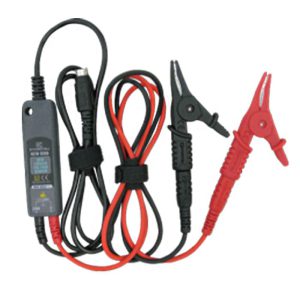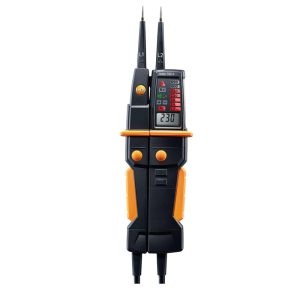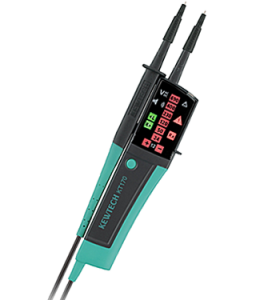Table of Contents
ToggleThe Best Voltage Detector for Your Electrical Testing Needs: How to Choose
Do you frequently work with electricity? Do you need to check the voltage or de-energization of electrical circuits or systems? In that case, you may want to spend money on a reliable voltage detector.
A voltage detector is a tool that can be used to check the voltage or de-energization of electrical circuits or systems. It may inform you whether or not there is voltage present and display the voltage value or range.
Additionally, it is capable of carrying out tests for continuity, phase rotation, and GFCI circuits. A voltage detector can assist you in troubleshooting any electrical issues as well as working with electricity safely and effectively.
But not every voltage detector is the same. Voltage detectors come in a variety of shapes and sizes, each with a unique set of characteristics and capabilities. Some voltage detectors are contact detectors, meaning you have to touch the terminals or wires with the device to test them.
Some voltage detectors can detect voltage without coming into contact with the object. Some devices have LED displays that use lights to show the nominal voltage. Some LCD screens feature numbers that represent the real voltage.
Some are user-friendly and have straightforward designs. Some have intricate designs with multiple functions.
So how do you pick the voltage detector that’s right for you? How can you contrast various voltage detectors to get the one that best meets your requirements and preferences? We’ll aid you in finding the answers to these queries in this article.
Four voltage detectors from Kyoritsu and testo, two well-known names in the electrical testing sector, will be compared. We’ll examine their attributes, capabilities, benefits, drawbacks, costs, and accessibility.
We will also provide you with some advice on how to select the best voltage detector for you depending on your preferences, skill level, budget, and purpose.
You will know more about these four voltage detectors by the conclusion of this essay and be able to make an educated choice. Additionally, you will discover the proper and safe way to use a voltage detector. So let’s get going!
KEW 8309 Voltage Sensor by Kyoritsu
The Kyoritsu KEW 8309 Voltage Sensor is the first voltage detector we will contrast. This non-contact voltage detector has a high sensitivity range and can detect AC voltages between 70V and 1000V.
This indicates that using this equipment to test the wires and terminals requires no contact with them. It will tell you if there is voltage there if you only bring it close to the wires or terminals.
To make voltage detection simple and secure, this voltage detector includes an integrated lamp, a buzzer, and a vibration feature. In order to preserve battery life, it also offers an auto power off option.
Although it is very easy to use and convenient, this voltage detector does not display the precise voltage value or carry out any other test functions. It is perfect for quickly and easily identifying live or damaged wires without having to touch them.
Anyone who needs to find live or broken wires without touching them can use this voltage detector. Electricians who need to determine whether a circuit is active or not before working on it will find it to be of particular utility. It is also helpful for technicians who need to locate loose connections or broken wires in order to solve electrical issues.
Before purchasing this voltage detector, you should weigh its benefits and drawbacks. Here are a few examples:
Advantages:
Utilizing it is very simple and secure. With this tool, you can test the wires and terminals without ever touching them.
It is highly sensitive and can pick up AC voltages between 70 and 1000 volts.
To warn you when electricity is detected, it includes an integrated spotlight, a buzzer, and a vibration feature.
To preserve battery life, it offers an auto power off feature.
Disadvantages:
It does not do any other test operations or display the precise voltage value.
DC voltages cannot be detected; only AC voltages can.
Interference or outside noise may have an impact.
Online, this voltage detector costs about $30. It is available from Amazon.com and other online merchants.
The Kyoritsu KT 170 and KT 171 voltage testers
The Kyoritsu Voltage Testers KT 170 and KT 171 are the second and third voltage detectors that we will contrast. These two voltage tester types have LEDs and LCDs and can test AC and DC voltages up to 690V.
It is necessary to touch the wires or terminals with these contact voltage testers in order to test them. A penlight for testing in the dark, an audible indicator, huge, bright LEDs that are visible in the dark, an ergonomic design that fits in the hand, and adjustable test tips of 2mm or 4mm are all features of their original design.
They are capable of conducting continuity tests, phase rotation tests, and single-pole phase tests. Additionally, they have two features: battery-free measurement and self-testing with all LEDs on.
The key distinction between the KT 170 and KT 171 is that the latter features an LCD display, whereas the former does not. The LCD display of the latter displays the actual voltage measurements with a resolution of 0.1V or 1V depending on the range.
These voltage testers can display the nominal voltage with LEDs and the actual voltage with LCD (only for KT 171), making them appropriate for more accurate and thorough voltage testing.
Anyone who needs to measure AC and DC voltages with LEDs and LCD can use one of these voltage testers. For electricians who need to check electrical circuits or systems for voltage or de-energization, they are extremely helpful.
Additionally, they are helpful to technicians who must carry out various test procedures like continuity tests, phase rotation tests, and single-pole phase tests.
Before purchasing these voltage testers, you should weigh their benefits and drawbacks. Here are a few examples:
Advantages:
With LEDs and LCDs, they can test AC and DC voltages up to 690V.
A penlight for testing in the dark, an audible indicator, huge, bright LEDs that are visible in the dark, an ergonomic design that fits in the hand, and adjustable test tips of 2mm or 4mm are all features of their original design.
They are capable of conducting continuity tests, phase rotation tests, and single-pole phase tests.
They have two uses: battery-free measuring and self-testing with all LEDs on.
Disadvantages:
To test them, you must touch the wires or terminals with the apparatus.
Both excessive voltage and the wrong polarity might cause damage to them.
They are susceptible to interference or noise from outside sources.
Online, these voltage testers go about $50. They are available from Amazon.com and other online merchants.
tester for voltage testo 750-3
Testo 750-3 Voltage tester is the fourth voltage detector we shall evaluate. With LEDs and an LCD, this digital voltage tester can check AC and DC voltages up to 690V. Another contact voltage tester, you must touch the wires or terminals with this one in order to test them.
It contains a hold function, a vibrating load button, a built-in flashlight for testing in the dark, and a patented all-around viewable LED voltage bar indication that can be seen from any position.
By connecting a 35 mA load to the circuit, it may test the GFCI circuit on AC outlets. Additionally, it is capable of conducting continuity, phase rotation, and single-pole phase tests. Although very inventive and adaptable, this voltage tester also needs batteries to function.
Anyone who needs to carry out various test functions, such as GFCI circuit testing, phase rotation testing, and continuity testing with LEDs and LCD, can use this voltage tester.
For electricians who need to check electrical circuits or systems for voltage or de-energization, it is extremely helpful. It is helpful for technicians who need to put a load to the circuit in order to diagnose electrical issues.
Before purchasing this voltage tester, you should weigh its benefits and drawbacks. Here are a few examples:
Advantages:
It can carry out numerous tests, including GFCI circuit testing, phase rotation testing, and continuity testing using LEDs and LCD.
It contains a hold function, a vibrating load button, a built-in flashlight for testing in the dark, and a patented all-around viewable LED voltage bar indication that can be seen from any position.
With an LCD, the voltage value can be displayed.
Disadvantages:
To test the wires or terminals, you must touch them directly with the apparatus.
To function, batteries are needed.
Overvoltage or the wrong polarity can harm it.
Online, this voltage meter costs about $100. It is available from Amazon.com and other online merchants.
How to Pick Your Ideal Voltage Detector
You should take into account your preferences, skill level, budget, and goal while selecting the best voltage detector for you. Before making a purchase, consider these inquiries:
What are your financial limits for a voltage detector?
What sort of voltage testing is required? Do you need to determine the precise voltage value or can you just look for voltage?
Which type of voltage detector do you prefer: touch or non-contact? Which do you prefer, LED or LCD? Do you Favor a straightforward or intricate design?
How well-versed in electrical testing are you? Do you require a voltage detector that is simple to use or one with more features?
You can reduce your selections and choose the best voltage detector for you based on the answers to these questions.
Based on our comparison, the following broad recommendations are made:
Choose Kyoritsu KEW 8309 Voltage Sensor if you have a limited budget and only need to find live or broken wires without touching them.
Choose Kyoritsu Voltage Testers KT 170 or KT 171 if you need to measure AC and DC voltages with LEDs and LCDs and have a moderate budget. You can select the KT 171 if you want to use an LCD to display the voltage value.
KT 170 is an option if you don’t need LCD.
Choose the testo 750-3 Voltage tester if you need to perform a variety of test functions, such as GFCI circuit testing, phase rotation testing, and continuity testing with LEDs and LCD, and you have a large budget.
You can compare these four voltage detectors in this post in the hopes of making an informed choice. Keep in mind to always use electrical devices in accordance with the safety instructions. Happy evaluating!
Click on the links below to see the top offers and discounts on any of these voltage detectors if you’re interested in purchasing them:
Kyoritsu Voltage Testers KT 170 and Kyoritsu KEW 8309 Voltage Sensor
Voltage tester Kyoritsu Voltage Testers KT 171 testo 750-3
We appreciate you reading this article. We sincerely hope you enjoyed and benefited from it. Please leave a comment in the section below if you have any queries or suggestions. We’d be thrilled to hear from you.




